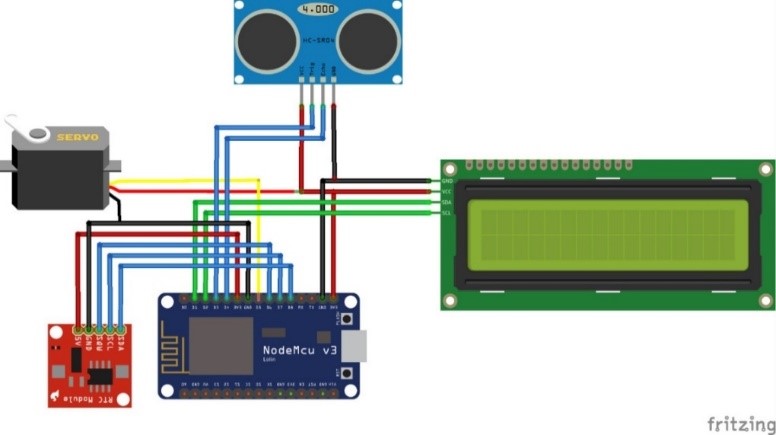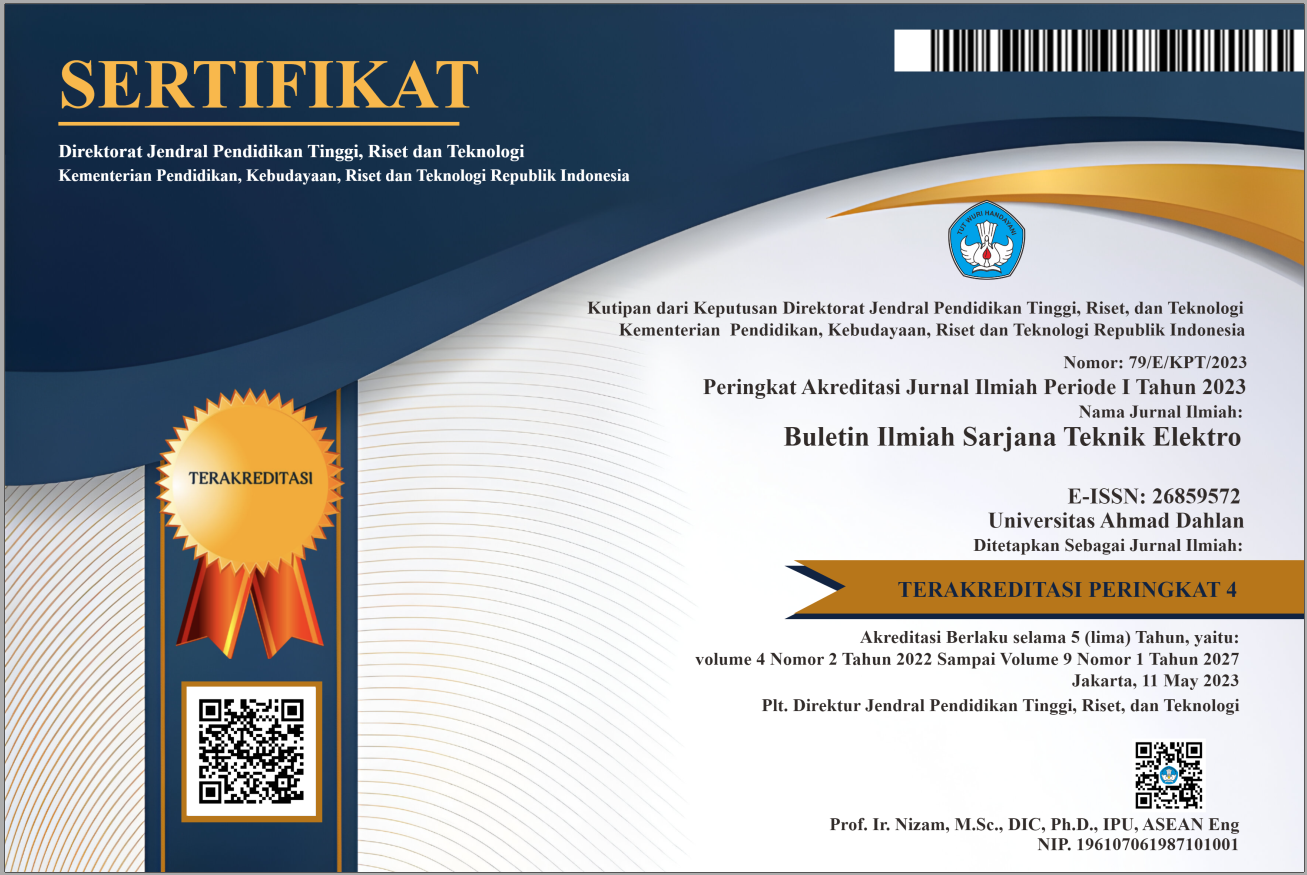Automatic Feeding System in Pond Fish Farming Based on the Internet of Things
DOI:
https://doi.org/10.12928/biste.v5i2.5784Keywords:
Internet of Things (IoT), NodeMCU, WiFi, Real Time Clock (RTC) , Ultrasonic , Motor ServoAbstract
One of the fish commodities consumed by the Indonesian people is catfish because it tastes good. Cultivation of catfish requires special attention regarding feeding because if it is not enough it can cause the fish to become cannibals, whereas if too much feed can cause disease. Therefore, it is necessary to monitor and control the provision of fish feed on a scheduled basis. This study aims to facilitate catfish farming in automatically scheduled fish feeding by utilizing the Internet of Things (IoT). This system is built using a NodeMCU micro controller which is connected to a Real Time Clock (RTC) sensor to adjust the feeding schedule. In addition, ultrasonic sensors are used to monitor feed conditions and servo motors to open and close the fish feed storage valve. This study succeeded in providing catfish feed automatically and on time according to a predetermined schedule, namely at 06.00 am, 12.00 noon, and 18.00 pm. Timing is based on the active hours of catfish. The system has also been successfully monitored and controlled remotely via the internet using the Blynk application. In addition, the system has also been able to identify the remaining feed reserves remaining in the storage container. This automatic feeding system has been operating in accordance with the purpose of the system, which is to provide fish feed according to the feeding hours of catfish so that cannibals or fish that are sick with ammonia are not found from leftover feed that is not eaten by catfish.
References
S. Wijaya, "Indonesian food culture mapping: a starter contribution to promote Indonesian culinary tourism," Journal of Ethnic Foods, vol. 6, no. 1, pp. 1-10, 2019, https://doi.org/10.1186/s42779-019-0009-3.
I. Gani et al., "Makassar Strait Area Development in Indonesia Based on the Marine Economy Sector," Economies, vol. 10, no. 8, p. 195, 2022, https://doi.org/10.3390/economies10080195.
J. D. Durand, "Fish diversity along the Mekong River and Delta inferred by environmental-DNA in a period of dam building and downstream salinization," Diversity, vol. 14, no. 8, p. 634, 2022, https://doi.org/10.3390/d14080634.
G. S. Araujo, J. W. A. Silva, J. Cotas and L. Pereira, "Fish Farming Techniques: Current Situation and Trends," Journal of Marine Science and Engineering, vol. 10, no. 11, p. 1598, 2022, https://doi.org/10.3390/jmse10111598.
H. Setiyowati, M. Nugroho and A. Halik, "Developing a Blue Economy in Depok West Java, Indonesia: Opportunities and Challenges of Neon Tetra Fish Cultivation," Sustainability, vol. 14, no. 20, p. 13028, 2022, https://doi.org/10.3390/su142013028.
T. Mahmudiono, T. S. Nindya, Q. Rachmah, C. Segalita and L. A. A. Wiradnyani, "Nutrition education intervention increases fish consumption among school children in Indonesia: results from behavioral based randomized control trial," International Journal of Environmental Research and Public Health, vol. 17, no. 19, p. 6970, 2020, https://doi.org/10.3390/ijerph17196970.
A. Said and D. MacMillan, "‘Re-grabbing’marine resources: a blue degrowth agenda for the resurgence of small-scale fisheries in Malta," Sustainability Science, vol. 15, no. 1, pp. 91-102, 2020, https://doi.org/10.1007/s11625-019-00769-7.
S. Huang and Y. He, "Management of China's capture fisheries: review and prospect," Aquaculture and Fisheries, vol. 4, no. 5, pp. 173-182, 2019, https://doi.org/10.1016/j.aaf.2019.05.004.
M. Føre et al., "Precision fish farming: A new framework to improve production in aquaculture," biosystems engineering, vol. 173, pp. 176-193, 2018, https://doi.org/10.1016/j.biosystemseng.2017.10.014.
C. A. Hoga, F. L. Almeida and F. G. Reyes, "A review on the use of hormones in fish farming: Analytical methods to determine their residues," CyTA-Journal of Food, vol. 16, no. 1, pp. 679-691, 2018, https://doi.org/10.1080/19476337.2018.1475423.
S. Pouil et al., "Nutrient budgets in a small-scale freshwater fish pond system in Indonesia," Aquaculture, vol. 504, pp. 267-274, 2019, https://doi.org/10.1016/j.aquaculture.2019.01.067.
M. A. Opiyo, E. Marijani, P. Muendo, R. Odede, W. Leschen and H. Charo-Karisa, "A review of aquaculture production and health management practices of farmed fish in Kenya. International journal of veterinary science and medicine, vol. 6, no. 2, pp. 141-148, 2018, https://doi.org/10.1016/j.ijvsm.2018.07.001.
G. Gao, K. Xiao and M. Chen, "An intelligent IoT-based control and traceability system to forecast and maintain water quality in freshwater fish farms. Computers and Electronics in Agriculture, vol. 166, p. 105013, 2019, https://doi.org/10.1016/j.compag.2019.105013.
J. Y. Lin, H. L. Tsai and W. H. Lyu, "An integrated wireless multi-sensor system for monitoring the water quality of aquaculture" Sensors, vol. 21, no. 24, p. 8179, 2021, https://doi.org/10.3390/s21248179.
A. Kusmayadi, Y. K. Leong, H. W. Yen, C. Y. Huang and J. S. Chang, "Microalgae as sustainable food and feed sources for animals and humans–biotechnological and environmental aspects," Chemosphere, vol. 271, p. 129800, 2021, https://doi.org/10.1016/j.chemosphere.2021.129800.
G. Kawamura, J. X. Lim, F. F. Ching, S. Mustafa and L. S. Lim, "Possible sensory control of cannibalism in the African catfish (Clarias gariepinus) larvae by electrical ablation of electroreceptors," Aquaculture, vol. 542, p. 736870, 2021, https://doi.org/10.1016/j.aquaculture.2021.736870.
R. T. Lampman, A. N. Maine, M. L. Moser, H. Arakawa and F. B. Neave, "Lamprey aquaculture successes and failures: A path to production for control and conservation," Journal of Great Lakes Research, vol. 47, pp. S201-S215, 2021, https://doi.org/10.1016/j.jglr.2020.10.006.
F. L. Valiente et al., "Internet of Things (IOT)-Based Mobile Application for Monitoring of Automated Aquaponics System," 2018 IEEE 10th International Conference on Humanoid, Nanotechnology, Information Technology,Communication and Control, Environment and Management (HNICEM), , pp. 1-6, 2018, https://doi.org/10.1109/HNICEM.2018.8666439.
A. Akhriana, I. Intan, N. Tamsir, N. Nirwana, R. W. Rahmi and R. Rahmadani, "Microcontroller Application in Feeding Fish Using an Android Mobile," 2021 3rd International Conference on Cybernetics and Intelligent System (ICORIS), pp. 1-6, 2021, https://doi.org/10.1109/ICORIS52787.2021.9649453.
N. N. Misra, Y. Dixit, A. Al-Mallahi, M. S. Bhullar, R. Upadhyay and A. Martynenko, "IoT, Big Data, and Artificial Intelligence in Agriculture and Food Industry," in IEEE Internet of Things Journal, vol. 9, no. 9, pp. 6305-6324, 2022, https://doi.org/10.1109/JIOT.2020.2998584.
W. -C. Hu, L. -B. Chen, B. -K. Huang and H. -M. Lin, "A Computer Vision-Based Intelligent Fish Feeding System Using Deep Learning Techniques for Aquaculture," in IEEE Sensors Journal, vol. 22, no. 7, pp. 7185-7194, 2022, https://doi.org/10.1109/JSEN.2022.3151777.
D. Biswas, S. Barai and B. Sau, "A WiFi-based Self-Organizing Multi-Hop Sensor Network for Internet of Things," 2021 International Conference on Innovative Trends in Information Technology (ICITIIT), pp. 1-6, 2021, https://doi.org/10.1109/ICITIIT51526.2021.9399609.
G. Y. Sriram and N. B. Sai Shibu, "Design and Implementation of Automated Aquaponic System with Real-time Remote Monitoring," 2021 Advanced Communication Technologies and Signal Processing (ACTS), pp. 1-6, 2021, https://doi.org/10.1109/ACTS53447.2021.9708396.

Published
How to Cite
Issue
Section
License
Copyright (c) 2023 Tomy Chandra Mahendra, Sunardi Sunardi

This work is licensed under a Creative Commons Attribution-ShareAlike 4.0 International License.
Authors who publish with this journal agree to the following terms:
- Authors retain copyright and grant the journal right of first publication with the work simultaneously licensed under a Creative Commons Attribution License that allows others to share the work with an acknowledgment of the work's authorship and initial publication in this journal.
- Authors are able to enter into separate, additional contractual arrangements for the non-exclusive distribution of the journal's published version of the work (e.g., post it to an institutional repository or publish it in a book), with an acknowledgment of its initial publication in this journal.
- Authors are permitted and encouraged to post their work online (e.g., in institutional repositories or on their website) prior to and during the submission process, as it can lead to productive exchanges, as well as earlier and greater citation of published work (See The Effect of Open Access).
This journal is licensed under a Creative Commons Attribution-ShareAlike 4.0 International License.


